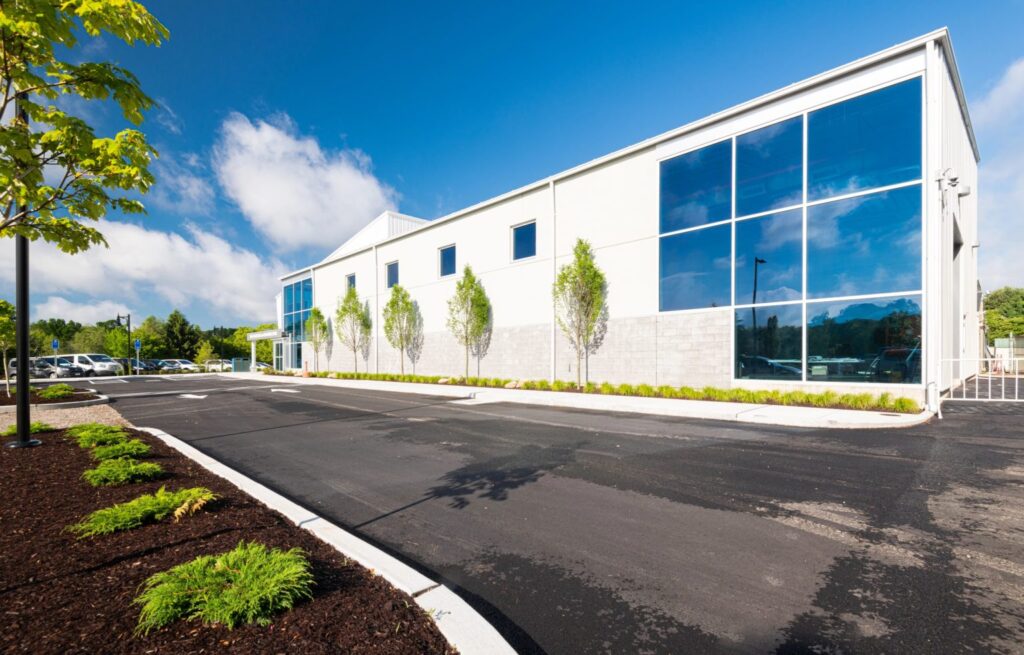Project Details

7000 sq ft of this facility protects 15 fish tanks containing more than 60,000 gallons of water.
Located on the Mystic Aquarium campus, in Mystic, Connecticut, the Milne Center for Ocean Science and Conservation is a fundamental space for furthering education and research in marine biology and environmental sciences. While the aquarium is a major tourist destination with exhibits featuring a variety of marine life, it is also a place for sea research and stewardship of the world’s oceans. The aquarium’s mission to continue research and conservation gave birth to the idea of the Milne Center.
The Milne Center for Ocean Science and Conservation provides a variety of functions on the aquarium’s campus. The first of these is as a conference and classroom space for events and ongoing educational programs offered by the aquarium. The space occupies approximately 11,000 sq ft of the facility. The remaining 7,000 sq ft provides for the needs of fish and invertebrate quarantine and holding, breeding of exotic species, research and recuperation for animals coming from the adjacent veterinary and surgery center. There are 15 tanks with over 60,000 gallons of water, the largest tank being 5,000 gallons. These large tanks are key in aiding the center’s conservation initiative to breed their own fish and aquatic life rather than wild capture, furthering Mystic Aquarium as one of the leading aquariums in STEM and marine conservation.
The conference space is large enough to accommodate up to 100 guests. Conferences and fundraising events like the annual “Ocean Commotion Gala”, a philanthropic event for Mystic Aquarium’s mission of environmental conservation, are held here. Prior to the erection of this building, classes were scattered throughout the campus. Now, there is one centralized area for classes to be conducted. The building is also home to the first and only licensed preschool, aptly named Sea School.
Efforts to get this project started began in 2012. The first and largest hurdle to make this vision a reality was gaining access to funding. George M. Milne, Jr., known for being the former president of Pfizer Central Research, provided the funding to get the project started. In addition to his lifelong dedication to human and animal health research and development, Milne understood the importance of having additional space for exploration and growth at the aquarium. Over the lifetime of the project, the vision of how the space was to be utilized continued to change and develop. The original proposal for the building was a research center for laboratory space with an administration component. With this ambitious vision, it was of utmost importance to have the best team possible to work on the project.
For a project as important as this, the aquarium enlisted the trusted, authorized Butler Builder, Carlin Construction Company. Experience in the construction industry since 1975, as well as a long-standing relationship with Mystic Aquarium since 2001, gave assurance to all involved that Carlin Construction could complete the project envisioned. Several on-campus projects completed by Carlin Construction incorporated Butler products and systems, including construction of a two-story addition to the main aquarium building containing 8,000 sq ft of offices, construction of a new open-sided canopy over a large recovery pool using galvanized Butler frames and MR-24 roofing, and several smaller projects using Butler wall panels.
Since the Milne Ocean Center needed to serve a wide variety of purposes, it was important that the architect, David Holmes, of Capital Studio Architects, had flexibility in the design. To overcome some challenges, it took the collaboration of the architect’s vision and Butler’s capabilities to come up with a solution that was made with conventional steel and Butler’s long-lasting roof system.
Carlin Construction recommended the use of Butler systems for this project, knowing that Butler could handle the complexities of design and engineering needed for perpendicularly joining the two separate structures that make up the Milne Center. Mystic Aquarium, being familiar with the quality and performance characteristics of Butler systems from previous projects, understood and endorsed the recommendation of Carlin. Flexibility in design and use of Butler products and non-Butler products ultimately allowed for a customized structure that would meet the needs of Mystic Aquarium. Dan Carlin, Director of Operations at Carlin Construction Company, stated:
“The integration of Butler and non-Butler products is something I’m very proud of.”
Not only is the building being used for advancements in conservation, but the building itself is also doing its part in energy efficiency. Some of the benefits provided to the project by Butler include the use of Butler’s TBS™ insulation system in the Fish and Invertebrate section of the facility and the TBS™ insulation system in the conference and classroom portions of the building. The thermal performance of these systems resulted in greater energy efficiencies that reduced heating and cooling needs and provide an economic benefit for years to come. In addition, the use of the Thermaliner roof system provided a beautifully finished ceiling that matched well with the modern industrial look of the mechanical systems and tanks in this section of the building. Butler also provided the engineering to support the future addition of solar panels to the south-facing part of the building’s roof. This is the first of many Carlin Construction buildings that will be designed to include solar panels.
Mystic Aquarium is part of an institute called the Sea Research Foundation, a non-profit organization. The foundation’s focus on conservation, education, research, and youth development continues to make progress toward a brighter future in the Milne Center. Inspiring and educating people to protect our oceans through conservation has made Mystic Aquarium and its Milne Center a leading force in marine biology and environmental sciences that will be treasured and appreciated for many years to come.
Carlin Construction Company
David Holmes of Capital Studio Architects
Connect with us for details about how we can solve your specific wall system needs.
© 2025 BlueScope Buildings North America, Inc. All rights reserved. Butler Manufacturing™ is a division of BlueScope Buildings North America, Inc.